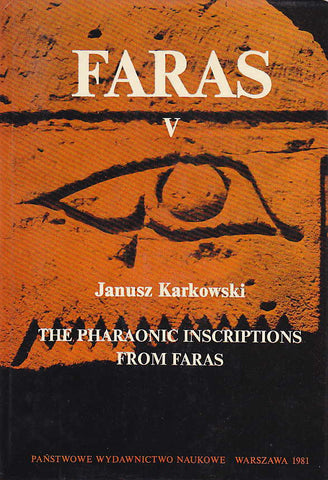Faras V, The Pharaonic Inscriptions from Faras
150,00 $
ISBN: 83-01-01299-4
Description: hardback, dustjacket, cloth, 372 pp. (21x29cm), figs. in text, 40 plates
Condition: very good
Weight: 1390g.
Janusz Karkowski, Faras V, The Pharaonic Inscriptions from Faras, Warsaw 1981
PREFACE
LIST OF PLATES
ABBREVIATIONS
Part I. THE HISTORICAL PROBLEMS
Chapter 1
THE DISCOVERY OF PHARAONIC FARAS
Chapter 2
THE HISTORICAL VALUE OF THE ARCHAEOLOGICAL AND EPIGRAPHICAL SOURCES
FROM FARAS
Chapter 3
THE GEOGRAPHICAL POSITION OF FARAS AND THE KNOWN SITES WITH PHARAONIC
MATERIAL
Chapter 4
PROBLEM OF THE ANCIENT TOPONYMES CONNECTED WITH FARAS
(ftc-k3v-Rc-mry-Mntw 18; Intt-t3wy or &sf-Md3w 19; IbSk 21; 3bw-rsyt 25; Shtp-ntrw 28)
Chapter 5
THE ORIGIN OF THE FRAGMENTS FOUND INSIDE THE MEROITIC ENCLOSURE AND THEIR
IMPORTANCE FOR STUDIES ON THE LOWER NUBIAN TEMPLES OUTSIDE FARAS
A. The Tuthmoside fragments
a. The question of the Buhen origin
(The direct and indirect connections 31; The accordances in measurements 33; Coincidences in the characteristics of the Buhen temple and the Faras fragments
and in their inscriptions and decorations 35)
b. The importance of the Buhen fragments found at Faras
1. The location of the fragments in the Southern Temple at Buhen
(The architrave fragments 37; The door fragments 48; The wall fragments 50)
2. The architecture of the temple and the history of its construction
3. The cult_ in the Southern Temple at Buhen
B. The post-Tuthmoside fragments
Chapter 6
THE HISTORY OF PHARAONIC FARAS
Part II. THE CATALOGUE
GENERAL REMARKS
A. THE HATHOR ROCK
a. The temple (1-11. Stelae, etc., scarabs and scaraboids excluded 77; 12-55 (1-63). Scarabs and scaraboids 92)
Appendix I. The list of the uninscribed objects from the Hathor Rock,
Addendum
b. The chapel of Setau
B. THE WALLED TOWN OF TUTANKHAMUN
a. The temple
b. The chapel of Huy and Ta-em-wadjsy and the minor objects
Addendum
Appendix II. Uninscribed sculptures found re-used in the Meroitic tombs
C. THE MEROITIC ENCLOSURE
a. The Tuthmoside fragments
82-146. The architraves inscribed with the larger incised signs
82-123. The texts reading from the left
(82-84. The initial scenes 141; 85-91. The titulary of Hatshepsut, changed into this of Tu-thmosis n 142; 92-102. The fragments of the dedicatory formulae
146; 103-108. The fragments of the titulary of Tuthmosis in 152; 109-115. The other texts 156; 116-123. The ending formulae 160)
124-145. The texts read from the right
(124-129. The fragments of Hatshepsut's titulary 163; 130-134. The fragments of the dedicatory formulae!69; 135-136. The fragments of the titulary of Tuthmosis ni 171; 137-143. The other texts 172; 144-145. The fragments of the ending formulae 176)
146 (1-7). The seven fragments with small portions of signs or of the bordering bands
147-153. The architraves inscribed with the smaller incised signs
147-151. The texts read from the left
152. The connection of the eight fragments with the text read from the right
153. The fragment bearing the band border
154-176. The architraves inscribed in low-relief
154-164. The texts read from the left
165-176. The texts read from the right
177-199. The door fragments
200-205. Six architrave or lintel fragments
206-288. The wall fragments
206-214. The figures of divinities
215-222. The royal figures
223-226. The unidentified figures
227-231. The bird-shaped tutelary divinities
232-261. The superscriptions of wall scenes
(232-253. The inscriptions over the divinities 224; 254-261. The inscriptions over royal figures 242)
262-269. The untypical texts
270-280. An unidentified wall decoration
281-282. Fragments of the side block border of a wall decoration
283-288(1-5). The wall friezes
(283. The cobras frieze 256;- 284-287(1-22). The Adter-friezes in low-relief 257; 288 (1-5). Five fragments of the Aefcer-frieze in sunk-relief 263)
289(1-41). The fragments of the Egyptian cornice
290(1-36). The roofing slabs and the untypical temple fragments
291-292. The other Tuthmoside fragments
(291. Two fragments of the base of a statue of the viceroy Nehi 272
292. The inscription of Amenhotep II 276)
b. The post-Tuthmoside fragments
293-433. The Ramesside fragments
293-304. Large-scale representations in sunk-relief
305-318. Medium-sized representations in sunk-relief
319-323. The small-scale representations in sunk-relief
324-327. The representations of priests in sunk-relief
328-338. Other fragments bearing the sunk-relief representations (offering scenes excluded)
339-343. The lintel decoration and inscriptions concerning Behdety in sunk-relief
344-372. The sunk-relief superscriptions of wall scenes
373-376. The large-scale vertical texts in sunk-relief
377-385. The horizontal texts in large, sunk-relief characters
386-392. The cartouche-friezes in sunk-relief
393-398. The representations of offerings in sunk-relief
399-408. The remaining wall decoration in sunk-relief (heker-fiiezes excluded)
409-424(2). Decoration in low-relief
425-429. Heker-friezes
(425-426. Heker-friezes in sunk-relief 337; 427-429. Heker-friezes in low-relief 338) 430(1-4). Four fragments of the Egyptian cornice
431-433. The other Ramesside fragments
(431. Inscription of Ramesses III 339; 432-433. Private inscriptions 340)
434-445. The Taharka fragments
INDICES
1. General
2. Egyptian
3. Concordances of the museums and catalogue numbers
PLATES

